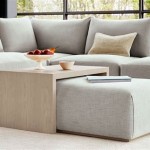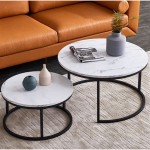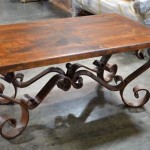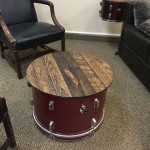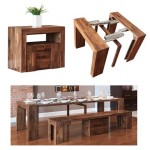How Far Should a Coffee Table Be From a Couch and Wall?
Determining the optimal distance between a coffee table, a couch, and any surrounding walls is a critical aspect of interior design that directly impacts both the functionality and aesthetic appeal of a living space. Achieving the right balance creates a comfortable and visually harmonious environment, facilitating ease of movement and access while maximizing the room's potential.
The placement of a coffee table is not simply a matter of personal preference; it involves careful consideration of several factors, including the size of the room, the dimensions of the furniture, and the intended use of the space. An improperly positioned coffee table can hinder traffic flow, make it difficult to reach for drinks or snacks, or disrupt the overall visual balance of the room. Conversely, when placed correctly, a coffee table enhances the functionality of the seating area, provides a focal point, and contributes to a well-designed and inviting living space.
This article will explore the key considerations and recommended guidelines for determining the ideal distance between a coffee table, a couch, and adjacent walls, providing practical insights to help achieve a functional and aesthetically pleasing living room layout.
Optimal Distance Between Coffee Table and Couch
The distance between the coffee table and the couch is a critical factor in creating a comfortable and functional seating area. The primary goal is to allow for easy access to the table from the couch while maintaining enough space for comfortable legroom and movement. A general guideline suggests maintaining a distance of approximately 14 to 18 inches between the edge of the couch and the edge of the coffee table. This range provides sufficient space to reach for items on the table without straining, while also preventing the table from being too far away to be conveniently used.
However, this range is not a fixed rule and may need to be adjusted based on specific circumstances. For instance, if the couch is particularly deep or if individuals using the space are taller, a slightly greater distance may be more comfortable. Conversely, in smaller rooms, a slightly shorter distance might be necessary to maximize the available space. The key is to ensure that the distance is comfortable and practical for the intended users of the space.
Another factor to consider is the height of the coffee table relative to the height of the couch. Ideally, the coffee table should be approximately the same height as the couch cushions, or slightly lower. This height relationship ensures that users can easily reach for items on the table without having to reach too far up or down. If the coffee table is significantly lower than the couch, it may be less convenient to use, while if it is significantly higher, it may obstruct the view and feel visually intrusive.
Ultimately, the optimal distance between the coffee table and the couch is a balance between accessibility and comfort. Experimenting with different distances and observing how they impact the functionality and comfort of the seating area is crucial in determining the best placement for a particular space.
Determining Distance Between Coffee Table and Wall
The distance between the coffee table and the surrounding walls is just as important as the distance between the coffee table and the couch. Maintaining adequate space around the coffee table ensures that the room feels open and airy, prevents it from feeling cramped, and allows for comfortable traffic flow. A general recommendation is to leave at least 30 to 36 inches of space between the coffee table and any walls or other furniture pieces. This allows people to easily walk around the table without bumping into it, and it also provides a visual buffer that prevents the room from feeling cluttered.
In smaller rooms, adhering strictly to the 30-36 inch guideline might not be feasible. In such cases, it is essential to prioritize functionality and traffic flow. Minimizing the distance between the coffee table and the wall may be necessary, but care should be taken to ensure that the space does not feel too cramped. Consider using smaller coffee tables or opting for designs that are more streamlined to maximize the available space. Multi-functional furniture is also valuable for limited spaces. For example, using coffee tables with storage, like drawers or shelves, can help reduce clutter in the room.
The placement of the coffee table relative to the wall should also take into account the location of doorways and pathways. Ensure that the coffee table does not obstruct any major traffic routes within the room. If necessary, adjust the placement of the table to create a clear and unobstructed path for people to move through the space. Angled placement will allow people to navigate around the table. Consideration of the door's swing is relevant if a doorway is nearby.
Furthermore, consider the visual impact of the coffee table's placement. If the coffee table is placed too close to the wall, it can create a sense of imbalance and make the room feel smaller. A properly positioned coffee table should contribute to the overall visual harmony of the space, acting as a focal point that anchors the seating area and creates a sense of balance. In addition, take into account the location of electrical outlets. Placing the coffee table in an area that requires running extension cords across the floor may be a safety hazard and an aesthetic issue.
Room Size and Furniture Dimensions Impact Placement
The overall dimensions of the room, as well as the size and shape of the couch and coffee table, significantly influence the optimal placement of the coffee table. In larger rooms, there is more flexibility in terms of placement, and it may be possible to adhere more closely to the recommended guidelines for spacing. However, in smaller rooms, careful planning and compromise are essential to maximize functionality and avoid creating a cramped feeling.
When working with a small room, consider using a smaller coffee table or opting for a different shape. Round or oval coffee tables can be more forgiving in tight spaces than rectangular ones, as they allow for easier navigation around the table. Glass-topped coffee tables can also create a sense of openness, as they allow light to pass through and do not visually weigh down the space. Likewise, the scale of the furniture should be considered. A large sectional couch in a small room will leave limited space for anything else. Selecting furniture that is appropriately sized for the room will greatly improve the arrangement potential.
In larger rooms, a larger coffee table can be used to fill the space and create a more substantial focal point. However, it is still important to ensure that there is adequate space around the table for comfortable movement. Consider using multiple smaller coffee tables instead of one large one. This can provide more flexibility in terms of placement and can also be visually appealing.
The shape of the room also plays a role in determining the optimal placement of the coffee table. In irregularly shaped rooms, it may be necessary to experiment with different layouts to find the best solution. Pay attention to the architectural features of the room, such as windows, doorways, and fireplaces, and consider how these elements impact the placement of the furniture. The placement of any rugs used in the seating area is important. The coffee table should be placed entirely on the rug or not on the rug at all. The size of the rug relative to the furniture will also play a role in the arrangement.
Ultimately, the key to successful coffee table placement is to carefully consider the specific characteristics of the room and the furniture, and to prioritize both functionality and aesthetics. By taking the time to plan and experiment, it is possible to create a living space that is both comfortable and visually appealing.
Beyond these general guidelines, personal preferences and lifestyle also play a role in determining the optimal distance between the coffee table, the couch, and the wall. Consider how the space will be used and adjust the placement accordingly. For example, if the space is primarily used for entertaining, it may be desirable to create a more open and spacious layout to facilitate conversation and movement. If the space is primarily used for relaxation, it may be preferable to create a more intimate and cozy atmosphere. Experiment with different arrangements to find what works best for individual needs and preferences.
:strip_icc()/cdn.cliqueinc.com__cache__posts__268833__how-to-choose-a-coffee-table-268833-1538077811019-image.700x0c-7a56fb07e0084a48b51032071b7fa87b.jpg?strip=all)
Don T Make This Living Room Coffee Table Mistake

Should Your Couch Touch The Wall A Guide To Perfect Placement Esperaa Homes

Sofa Placement Floating Vs Anchored Against The Wall Home

Are You Still Putting Furniture Against The Wall Gift Elements Sg

Behind The Couch Table Ideas For Your Living Room Stefana Silber

How To Organize Your Home Without Sacrificing Style

Is It Better To Have A Round Or Rectangular Coffee Table Swyft

Simple Guide For Decorating Your Living Room Beautiful Homes

What Should I Do With The Gap Between Sofa And Wall

Why You Should Never Push Your Furniture Up Against The Wall
Related Posts

